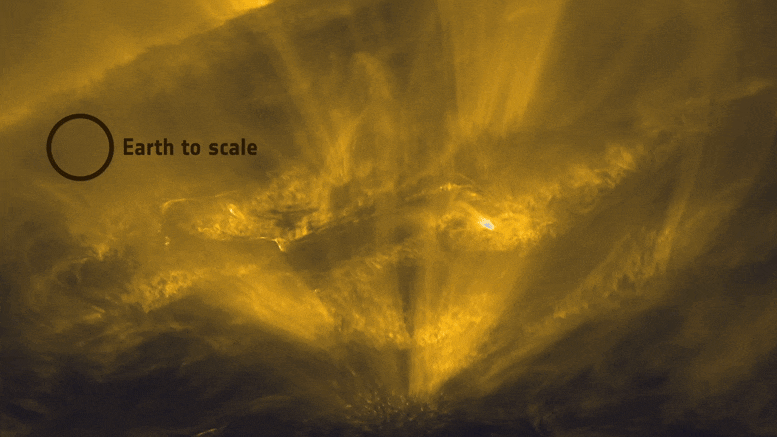
Although the analysis of the new dataset has only just begun, it is already clear that the ESA-led mission is providing the most extraordinary insights into the Sun’s magnetic behavior and the way this shapes space weather.
Some are remote-sensing instruments that look at the Sun, while others are in-situ instruments that monitor the conditions around the spacecraft, enabling scientists to ‘join the dots’ from what they see happening at the Sun, to what Solar Orbiter ‘feels’ at its location in the solar wind millions of kilometers away.
And as luck would have it, the spacecraft also soaked up several solar flares and even an Earth-directed coronal mass ejection, providing a taste of real-time space weather forecasting, an endeavor that is becoming increasingly important because of the threat space weather poses to technology and astronauts.
“The images are really breathtaking,” says David Berghmans, Royal Observatory of Belgium, and the Principal Investigator (PI) of the Extreme Ultraviolet Imager (EUI) instrument, which takes high-resolution images of the lower layers of the Sun’s atmosphere, which is known as the solar corona.This region is where most of the solar activity that drives space weather takes place.
This is no easy task because Solar Orbiter is revealing so much activity on the Sun at the small scale.
At present no one knows exactly what it is or how it formed in the Sun’s atmosphere.
It is the movement of these particles and the associated solar magnetic fields that create space weather.
A solar flare on March 21 occurred just behind the visible face of the Sun as seen by the ESA/NASA Solar Orbiter spacecraft.Nevertheless, the Extreme Ultraviolet Imager (EUI) and the X-ray Spectrometer/Telescope (STIX) instruments aboard the spacecraft both recorded the event as it rose above the Sun’s limb.
To chart the Sun’s effects on the heliosphere, the results from the in-situ instruments, which record the particles and magnetic fields that sweep across the spacecraft, must be traced back to events on or near the visible surface of the Sun, which are recorded by the remote sensing instruments.This is not an easy task as the magnetic environment around the Sun is highly complex, but the closer the spacecraft can get to the Sun, the less complicated it is to trace particle events back to the Sun along the ‘highways’ of magnetic field lines.Instead, they were produced in the solar atmosphere, nearer the Sun’s surface.
Solar activity such as flares and the giant eruptions known as coronal mass ejections are driven by the Sun’s magnetism.The ESA/NASA Solar Orbiter spacecraft investigates the Sun’s magnetic field in a number of different ways, allowing it to trace the field from the Sun’s surface out into space.
On the same day, the Radio and Plasma Waves (RPW) experiment saw them coming, picking up the strong characteristic sweep of radio frequencies produced when accelerated particles – mostly electrons – spiral outwards along the Sun’s magnetic field lines.While the particles that stream outwards into space are the ones that EPD and RPW detected, it is important to remember that other particles can travel downwards from the event, striking the lower levels of the Sun’s atmosphere.
The Extreme Ultraviolet Imager (EUI) and the X-ray Spectrometer/Telescope (STIX) instruments aboard the ESA/NASA Solar Orbiter spacecraft captured a solar flare erupting from an active region on the face of the Sun on March 2, 2022.The initial eruption of particles, known as a Coronal Mass Ejection (CME), carries a strong magnetic field that MAG can easily register, but energetic particles from the event travel much faster than the CME and can rapidly fill large volumes of space, and therefore be detected by Solar Orbiter.
When it comes to the magnetic field, it all begins at the Sun’s visible surface, known as the photosphere.This is where the internally generated magnetic field bursts into space.
This can see the north and south magnetic polarity on the photosphere, as well as the rippling of the Sun’s surface due to seismic waves traveling through its interior.
“This will track the evolution of the composition of the solar wind from the Sun to the spacecraft, and that tells us about the mechanisms responsible for the acceleration of the solar wind,” says SPICE PI Frédéric Auchère, Institut d’Astrophysique Spatiale, France.Tracking space weather.Credit: Central Sun image: ESA & NASA/Solar Orbiter/EUI team; corona imagery: SOHO (ESA & NASA); Solar Orbiter data: ESA & NASA/Solar Orbiter/MAG & SWA Teams; Wind data: NASA/GSFC/Wind Aurora: J Bant Sexson IV.
By combining data from all instruments, the science team will be able to tell the story of solar activity from the surface of the Sun, out to Solar Orbiter and beyond.The Sun’s south pole as seen by the ESA/NASA Solar Orbiter spacecraft on March 30, 2022, just four days after the spacecraft passed its closest point yet to the Sun.The magnetic fields that create the great but temporary active regions on the Sun get swept up to the poles before being swallowed back down into the Sun where they are thought to form the magnetic seeds for future solar activity.
This experience gave Solar Orbiter a taste of what it is like to forecast the space weather condition at Earth in real-time.Magnetism reaches out from the Sun’s interior, trapping some of the coronal gasses and creating bright loops that are easy to see reaching into space on the limb of the Sun.
Already the spacecraft is racing through space to line itself up for its next – and slightly closer – perihelion pass on 13 October at 0.29 times the Earth-Sun distance.
In this phase, Solar Orbiter will see the Sun’s polar regions more directly than ever beforeSuch line-of-sight observations are key to disentangling the complex magnetic environment at the poles, which may in turn hold the secret to the Sun’s 11-year cycle of waxing and waning activity